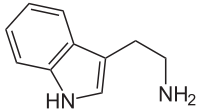- Trace Amine
-
Spurenamine (engl. trace amines) sind biogene Amine, die durch Decarboxylierung von Aminosäuren entstehen. Ihrem Namen entsprechend kommen sie im Körper nur in geringen Mengen vor. Ursprünglich wurde angenommen, dass sie ein Abfallprodukt bei der Synthese der Neurotransmitter Dopamin, Serotonin und Noradrenalin seien. Per Zufall jedoch entdeckte Beth Borowsky im Jahr 2001 eine neue Familie von Rezeptoren, die durch Spurenamine spezifisch stimuliert wurden. Sie taufte diese Rezeptoren TA1, TA3, TA4 und TA5. Weitere Rezeptortypen wurden bei Maus und Ratte gefunden.
Spurenamine erlangten durch weitere Arbeiten Aufsehen, da die Rezeptoren in dem Belohnungssystem des Gehirns, dem Nucleus accumbens exprimiert werden. Viele unserer Nahrungsmittel enthalten Spurenamine, so enthalten Käse und Bananen Tyramin. β-Phenylethylamin (PEA) und Tryptamin kommen in Schokolade vor. Seit der Entdeckung der Rezeptoren spricht man ihnen neben dem Serotonin und dem Theobromin einen psychisch aufhellenden Effekt zu (chocolate: the feel-good-food). Eine Fehlregulation im menschlichen Körper wird mit Schizophrenie und Depression in Verbindung gebracht, für möglich erachtet wird u. a. eine Rolle bei Migräne, Parkinson-Krankheit und ADHD.[1]
Zu den Spurenaminen zählen unter anderem:
- β-Phenylethylamin, ebenfalls strukturverwandt mit Dopamin
- Tyramin, strukturverwandt mit Dopamin
- Octopamin, strukturverwandt mit Noradrenalin
- Tryptamin, strukturverwandt mit Serotonin
(R)-4-Hydroxyamphetamin gehört zu den potentesten zur Zeit bekannten Agonisten am Spurenamin-Rezeptor, Typ TA1.[2]
Quellen
- ↑ L. Lindemann, M.C. Hoener (2005): A renaissance in trace amines inspired by a novel GPCR family, TIPS, Vol. 26, No. 5
- ↑ J.R. Bunzow et al. (2001): Mol. Pharmacol. Vol. 60 (6), S. 1181–88
Literatur
- Trace amines: Identification of a family of mammalian G-protein-coupled receptors (GPCR),Beth Borowsky et al., Christophe Gerald, Synaptic Pharmaceutical Corporation, Paramus, NJ, PNAS, June 2001, vol. 98
- Phenylethylamine and phenylacetic acid in CSF of schizophrenics and healthy controls, Beckmann H, Reynolds GP, Sandler M, Waldmeier P, Lauber J, Riederer P, Gattaz WF.
- Brain cannabinoids in chocolate,Emmanuelle di Tomaso, Massimiliano Beltramo, Daniele Piomelli, Description: SIR – Chocolate craving, common in western societies, is still incompletely, Nature 382, 677–678 (22 Aug 1996) Scientific Correspondence (from the Nature Archive: January 1987 – December 1996)
Wikimedia Foundation.




